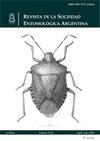First records of Meromacrus cactorum (Diptera: Syrphidae) from Chile, with new biological data
IF 0.5
4区 农林科学
Q4 ENTOMOLOGY
引用次数: 1
Abstract
The syrphid genus Meromacrus is widespread in the Neotropics, but its presence in Chile has been confirmed just recently. Adults pollinate, and larvae are saprophagous of vegetal materials. In this note, we report Meromacrus cactorum Ricarte et al. for the first time from Chile. New data on adult habitats and flower visitation are also provided for this Meromacrus. Adults were observed on flowers of the cacti Opuntia ficus-indica, Cumulopuntia sphaerica, and the vulnerable Browningia candelaris. Species distribution and pollinator potential are discussed for M. cactorum.智利仙人掌Meromacrus cactorum的首次记录和新的生物学数据
Meromacrus属广泛分布于新热带地区,但它在智利的存在最近才得到证实。成虫授粉,幼虫对植物材料有食腐性。在本说明中,我们首次报道了智利的Meromacrus cactorum Ricarte等人。关于成年栖息地和访花的新数据也为这种Meromacrus提供。在仙人掌仙人掌、球仙人掌和脆弱的坎德拉棕花上观察到成虫。讨论了仙人掌的物种分布和传粉潜力。
本文章由计算机程序翻译,如有差异,请以英文原文为准。
求助全文
约1分钟内获得全文
求助全文
来源期刊

Revista De La Sociedad Entomologica Argentina
Agricultural and Biological Sciences-Insect Science
CiteScore
0.80
自引率
20.00%
发文量
31
审稿时长
20 weeks
 求助内容:
求助内容: 应助结果提醒方式:
应助结果提醒方式:


